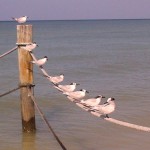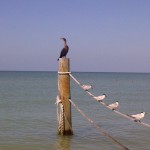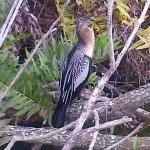 White Ibis in (my) Art From
White Ibis in (my) Art From 
Here are some of the birds I watch at the beach. I really never had time to enjoy all the birds that are in the area, so let me share some wonders I have enjoyed for years. Although, I was aware of them as a young child, they were something I never had time for. Later on in life, I purchased a set of binoculars for our oldest grandson, Owen Flomberg, so that he could have the same fascinations, but with his own choice. So if you enjoy the magical flights of birds, read-on.
Terns
Terns are a fairly common shorebird along the Gulf Coast ranging from the southern tip of Florida around to Texas tip. Terns feed by diving for small fish and crustaceans out at sea. The young can be distinguished by speckled dark black or brown feathers on their back and may lack the orange tip on the bill. They are in the same family, as gulls. This means they share some common characteristics. For example, gulls and terns have webbed feet and usually nest on the ground and near water. Terns differ from gulls in that they have narrower pointed wings, forked tails, pointed bills, and slimmer bodies.
Their bill is often aimed downward as they fly and hover in search for food.

These terns were spotted near the HVIII. 10/12/12
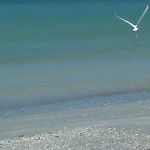
Caught this tern in flight when I walked by him.
I call this “taking terns”.
The Gull
Seagulls are most closely related to the terns and only distantly related to auks, skimmers, and more distantly to the waders. Most gulls, however; belong to the large family named Larus. The word Larus is from the Greek word meaning “ravenous sea bird”. The term “Seagull” can be misleading because many species of gulls live, feed, and nest inland. The gulls are relatively uniform in shape, but do vary in size and coloration. Seagulls are the acrobats of the sky, making the seemingly impossible antics appear effortless. They can float motionless in midair by catching wind currents with perfect timing and precision while positioning their bodies at just the right angle.
The seagull is perhaps best known as being a scavenger. It is most often seen in large, noisy flocks congregating wherever food is available. They can almost always be found around fishing boats, picnic grounds, parking lots, and garbage dumps. Many people consider the gull to be a nuisance, but they actually perform a very valuable service.
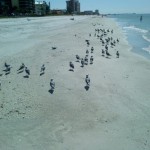 These sea gulls always hang out at the beach and barely move over when I walk by. They seem to be sociable until it comes to sharing!
These sea gulls always hang out at the beach and barely move over when I walk by. They seem to be sociable until it comes to sharing!
They are garbage men (sanitation engineers for the politically correct) with wings. They scavenge up great numbers of dead animals and organic litter which could pose a health threat to humans. I remember how I use to give the first four grandchildren the hose at Symphony Isles and let them try to spray them. Of course, they are great fliers and you found out it was next to impossible to spray them even with a hose!
Folklore from Scotland says “Seagull, sit on the sand; it’s a sign of rain when you are at hand.” Birds will roost in times of low pressure, which is often indicative of an oncoming storm. I see this on the beach at time of storms or weather changes. It is so evident! During early spring you will find them everywhere at the beach and in May the mothers are waiting for the eggs to hatch. Here on the island, they are protected and the nests are marked with rope.
Black Skimmer

Black skimmers “skim” the surface of the water with black-tipped bright red bills. The lower half of the bill is longer than the upper, allowing it to cut through the water and dip down to grab small fish encountered near the surface. They are my favorite bird to watch! I just enjoy how they can wait on the beach, until it is time to find food. They have a distinctive look about them, perhaps a distinguished look!
They are rare and do not nest in many parts of the world. You will find them on the beach from March to September of each year. On many of my visits, I am fortunate enough to see them and enjoy how graceful they are skimming along the shores catching food. They usually pick out a certain territory, fly one way, then turn around and fly back. I enjoy them most when they are standing along the beach with the certain look that they have. If you get too close, most of them will fly away and some of them become verbal.
Black Skimmer’s nesting. Black Skimmer’s In Flight. Black Skimmer’s Wading .
Throughout the shorebird nesting season, dozens of volunteers help educate visitors about the beach nursery. Black skimmers, Least Terns, and Plovers are all setting up nests here now.
People walking through the nesting area can cause several problems; as the bird nests are camouflaged and it’s easy to step on the eggs. If birds are scared off the nest for too long, the eggs can cook in the sun. And if there are too many people around, the birds won’t nest in that area again.
Therefore, when you spot protected nests, please keep your distance.
Close by these nests, you will usually find Sea Turtle nests as well.
Sea turtle nesting and hatching occurs each year from May 1st through October 31st. Female turtles come ashore in the dark, dig a hole using their flippers, and lay 100 to 150 eggs at a time. During the course of a season, a single female lays three to eight nests. After a 45 to 70 day gestation period, hatchlings emerge from the nest at night and follow the moonlight reflecting off the Gulf.
Skimmer Nest (6-13) Sea Turtle Nest (6-13)
Due to Sea Turtle Nesting, places along the beach are required to modify their lights; so as not to confuse the turtles from heading out to the beach once they are hatched. They usually look toward the light and can be easily confused if light is produced by all the residents along the beach and not the natural moon light.
Marine turtle nesting and hatching occurs each year from May 1st through October 31st. Female turtles come ashore in the dark, dig a hole using their flippers, and lay 100 to 150 eggs at a time. During the course of a season, a single female lays three to eight nests. After a 45 to 70 day gestation period, hatchlings emerge from the nest at night and follow the moonlight reflecting off the Gulf. Both nests were photographed south of the HVIII.
Cormorant
The Florida Cormorant seldom goes far out to sea, but prefers the neighborhood of the shores, being found in the bays, inlets, and large rivers
The Florida cormorant can dive down far into the water, thus making it a great hunter of fish as a food source. They swallow the fish whole down into their throats, so it is hard for the fish to get away, thus the quick cormorant is often successful with every dive for food.
The cormorants are a naturally patient creature when it comes to allowing their wings to dry, but appear hyper when in the water. They have a snake-like neck, and a head that resembles a duck. They are often mistaken for ducks when on the surface, until they dive under the water, often reappearing further away. Sometimes they are mistaken for turtles.
I rescued one once while boating and took him to the Bird Sanctuary in Indian Shores, where they helped him.
These were taken by the public beach in North Redington Beach.
These were taken while I was walking on the boardwalk in Carillion Park in March of 2013.
Seaside Sparrow
 This Seaside Sparrow was photographed while eating at the Beach House in Bradenton, FL.6/2013
This Seaside Sparrow was photographed while eating at the Beach House in Bradenton, FL.6/2013
There are a number of sparrows that live in Florida. I feed many of them in the mornings from my balcony at the beach when at the beach. I call them the seaside sparrow due to the fact they are at the beach, but they could be a house sparrow or another type. I have not classified them yet, but will. They are funny in the fact that they do not seem to walk, but hop everywhere they go on the balcony. They have gotten so use to me that should I leave the doors open, they will come in. Of course when Carol is there, she freaks, so I chase them out. On occasion I have told Teagan and Emre that I am feeding my friends, and Teagan replied, “Grandpa, they are not your friends. They are birds!” This made me “crack up” as sometimes they do not understand my humor, but as time goes on they will become more aware. On a recent visit to Florida our granddaughter, Lily, spoke to me and asked if my friends were going to be around! I thought this was hysterical, as she has such a sense of humor and of course I told her, “Yes… they are out there now”. Perhaps we will go out tonight and look for “Sea Turtles”, but Lily was scared of the dark and we only spent a few minutes outside that night searching. One day, perhaps “you” on another beach, another shore, or another place will have these wonderful experiences with things you love. By then, you may have your own “friends”.
I have a hard time photographing these, as when I open the door they take off! I joke with the grandkids that these are “my friends”.

This Seaside Sparrow picture was taken on the balcony of 305.
Great Blue Heron
 Whether at a river or walking the coastline, the Great Blue Heron is a majestic sight. This heron with its subtle blue-gray plumage often stands motionless as it scans for prey or wades belly deep with long, deliberate steps. They may move slowly, but Great Blue Herons can strike like lightning to grab a fish or snap up a gopher. In flight, look for this widespread heron’s tucked-in neck and long legs trailing out behind. I have had friends in Apollo Beach tell me of them striking and eating snakes along some of the ponds.
Whether at a river or walking the coastline, the Great Blue Heron is a majestic sight. This heron with its subtle blue-gray plumage often stands motionless as it scans for prey or wades belly deep with long, deliberate steps. They may move slowly, but Great Blue Herons can strike like lightning to grab a fish or snap up a gopher. In flight, look for this widespread heron’s tucked-in neck and long legs trailing out behind. I have had friends in Apollo Beach tell me of them striking and eating snakes along some of the ponds.
This Great Blue Heron was located near the patio on the north side of the HVIII. They are all over and I love how slow they walk and move until it is time to strike. They are very fast. They don’t seem scared of humans, but seem cautious instead. He inspired me to create a poem, but called it a Pelican instead.
Sandpiper
 Sandpipers are a large family, of shorebirds. They include many species called sandpipers, as well as those called by names such as curlew and snipe. The majority of these species eat small invertebrates picked out of the mud or soil. Different lengths of bills enable different species to feed in the same habitat, particularly on the coast, without direct competition for food. Sandpipers have long bodies and legs, and narrow wings. Most species have a narrow bill, but otherwise the form and length are quite variable.
Sandpipers are a large family, of shorebirds. They include many species called sandpipers, as well as those called by names such as curlew and snipe. The majority of these species eat small invertebrates picked out of the mud or soil. Different lengths of bills enable different species to feed in the same habitat, particularly on the coast, without direct competition for food. Sandpipers have long bodies and legs, and narrow wings. Most species have a narrow bill, but otherwise the form and length are quite variable.
The busy sand piper is always walking around looking for food. They are more guarded when you approach them. This one was just a little south of the pier near me.
Curlew
 Curlews are characterized by long, slender, down curved bills and mottled brown plumage. Curlews feed on mud or very soft ground, searching for worms and other invertebrates with their long bills. They will also take crabs and similar items.
Curlews are characterized by long, slender, down curved bills and mottled brown plumage. Curlews feed on mud or very soft ground, searching for worms and other invertebrates with their long bills. They will also take crabs and similar items.
Not my picture….. I hope to find one soon.
White Ibis
 The White Ibis of Florida feeds in Florida’s marshes, ponds, beaches, and mowed lawns. The White Ibis may be called a Floridian or friendly neighborhood bird. It is quite something to be sitting down to a cup of tea one morning, or lunch in the afternoon, and see a flock of the snowy white birds against the green grass, shoving their curved, reddish-orange beaks into your lawn for a snack of insects and worms.
The White Ibis of Florida feeds in Florida’s marshes, ponds, beaches, and mowed lawns. The White Ibis may be called a Floridian or friendly neighborhood bird. It is quite something to be sitting down to a cup of tea one morning, or lunch in the afternoon, and see a flock of the snowy white birds against the green grass, shoving their curved, reddish-orange beaks into your lawn for a snack of insects and worms.
These migratory birds are easily seen in Florida’s lake front areas, and any place where there is a body of water, but they love residential areas near water that have freshly mowed grass, for it makes their search for bugs as simple as the pelicans who dive for abundant bait fish in the ocean.
These guys can always be found along the shore, and some of them prefer fishing under or by the pier near the Sand Dollar.
Brown Pelican
The Brown Pelican the smallest of the eight species of pelican, although it is a large bird in nearly every other regard with a gular pouch on the bottom for draining water when it scoops out prey. The head is white, but often gets a yellowish wash in adult birds. The bill is grayish overall in most birds, though breeding birds become reddish on the underside of the throat. The back, rump, and tail are streaked with gray and dark brown, sometimes with a rusty hue. It is funny to watch them wiggle their tail after eating a meal or when they are happy.
I call this picture the “Florida Fishing Commission” due to the number of pelicans standing around.
Here you see the entire fishing village of pelicans! They can be found on the public beach about a mile away.
A Pelican in flight over the gulf. My “friend” at Redington Park.
Pelican Behavior
Pelicans are very gregarious birds; they live in flocks of both sexes throughout the year. They are exceptionally buoyant due to the internal air sacks beneath their skin and in their bones, and as graceful in the air as they are clumsy on land. In level flight, pelicans fly in groups, with their heads held back on their shoulders, the bills resting on their folded necks. They may fly in a “V”, but usually in regular lines or single file, often low over the water’s surface.
Pelicans fly to a considerable height over a school of fish then dive at a high speed into the water, often completely submerging itself below the surface as it quickly snaps up its prey before it can swim away. The pelican then comes back to the surface and spills the water out of his throat pouch that was been caught in the plunge and then throw back their head to swallow the prey.
Pelican Breeding
These birds nest in colonies, often times on islands and/or in mangroves. You will see most of them in the morning or late in the day on many of the protective keys while boating in the intercostal waterway. It is amazing how many of them roost in the mangroves. Pelican nesting peaks during March and April 28-30 days. Both parents actively care for the young may abandon their nest if stressed by visitors coming to close by. The mature pelican will allow you to get close to him either when walking on the beach or on a dock; but the nesting pelicans are more fearful. Usually, the ones on the beach think people are going to feed them.
Egrets
Snowy Egrets have black beaks and yellow feet.
Great Egrets have yellow beaks and black feet.
An egret is any of several herons, most of which are white or buff, and several of which develop fine plumes (usually milky white) during the breeding season. The distinction between a heron and an egret is rather vague, and depends more on appearance than biology.
I took these pictures of the Great Egret at the Clearwater fishing wharf. (Notice the yellow beak and black feet.)
Crows
 Ravens, in fact, do not live in Florida. But we do have two species of crows: the America crow and the fish crow. They are hard to tell apart. I have been feeding two of them on the balcony. Crows also have a wicked sense of humor. There are many stories of crows snipping clothespins off lines just to watch the clean sheets fall to the ground. Others like to undo shoelaces. I have gotten close to them without them being spooked, but have not had the camera around when I did. Crows also have their own, highly evolved language and society. They live in close-knit families of at least nine birds. The leader acts as a lookout, stationing him-self at the top of the tallest tree while others forage or attend to other crow business. They are also good mimics. This is one of three that visit and they are very brave. They have a tendency to hang out, but if I let them they will make a mess, so after feeding them I tell them to hit the air!
Ravens, in fact, do not live in Florida. But we do have two species of crows: the America crow and the fish crow. They are hard to tell apart. I have been feeding two of them on the balcony. Crows also have a wicked sense of humor. There are many stories of crows snipping clothespins off lines just to watch the clean sheets fall to the ground. Others like to undo shoelaces. I have gotten close to them without them being spooked, but have not had the camera around when I did. Crows also have their own, highly evolved language and society. They live in close-knit families of at least nine birds. The leader acts as a lookout, stationing him-self at the top of the tallest tree while others forage or attend to other crow business. They are also good mimics. This is one of three that visit and they are very brave. They have a tendency to hang out, but if I let them they will make a mess, so after feeding them I tell them to hit the air!
American Oystercatcher
Large shorebirds with white under parts, brown upper parts, black hood, long, bright red-orange needle-shaped bill. White wing patches visible in flight. Yellow eyes surrounded by orange eye-rings. Legs and feet are pink. They feed on mussels and other bivalves. I do not see a lot of these around, but will keep an eye on them or anything else I have missed for you.
“Finally, this is just something for you to look at and enjoy, but seek your own adventures, find birds, fish, wildlife, and fauna that interest you. All can be found around you from the coasts to the mainland. They are there waiting for you to enjoy”.
Originally, I wrote this for Owen Flomberg, in 2012 when I was buying him binoculars for his birthday. I wanted to include this section in the book, as I love to watch the various birds and was always fascinated by their character and manners of flight and feeding. As with many of us, there are times in our lives when we have time, but not the “extra time” needed for fill some of the passions we enjoy in life; even though, we know they are there. There are so many other commitments that were more important in those times and rightly so.
“Rarely will a person take notice of the shadow of a bird overhead, or the sounds and chirps that they make, or the colors that can be found, from browns and grays to blacks, to reds, whites and all colors in-between. They land, they fly, and they dive and entertain us from time to time. Let us make no mistake they are creatures of God (as we are) and their existence and similarities between us are far and few.
God gave us land, sea, skies, and animals not only for life, but for enjoyment. “Let us hope that all the above will be around for generations to come, so that all may appreciate what we have”.
Birds in their natural habitat have inspired me all my life! Partly, due to their looks and the ability to fly along with my favorite childhood dreams of being able to fly. I think of them as an extension of our soul and due to their nature, I am able to “fly” when I want.
On the fifth day, God created the creatures that live in the sea and the birds of the air. Read it for yourself in Genesis 1:20-23.
There is much more I wanted to explore and add here, but as time moves on so will I…
DLS

